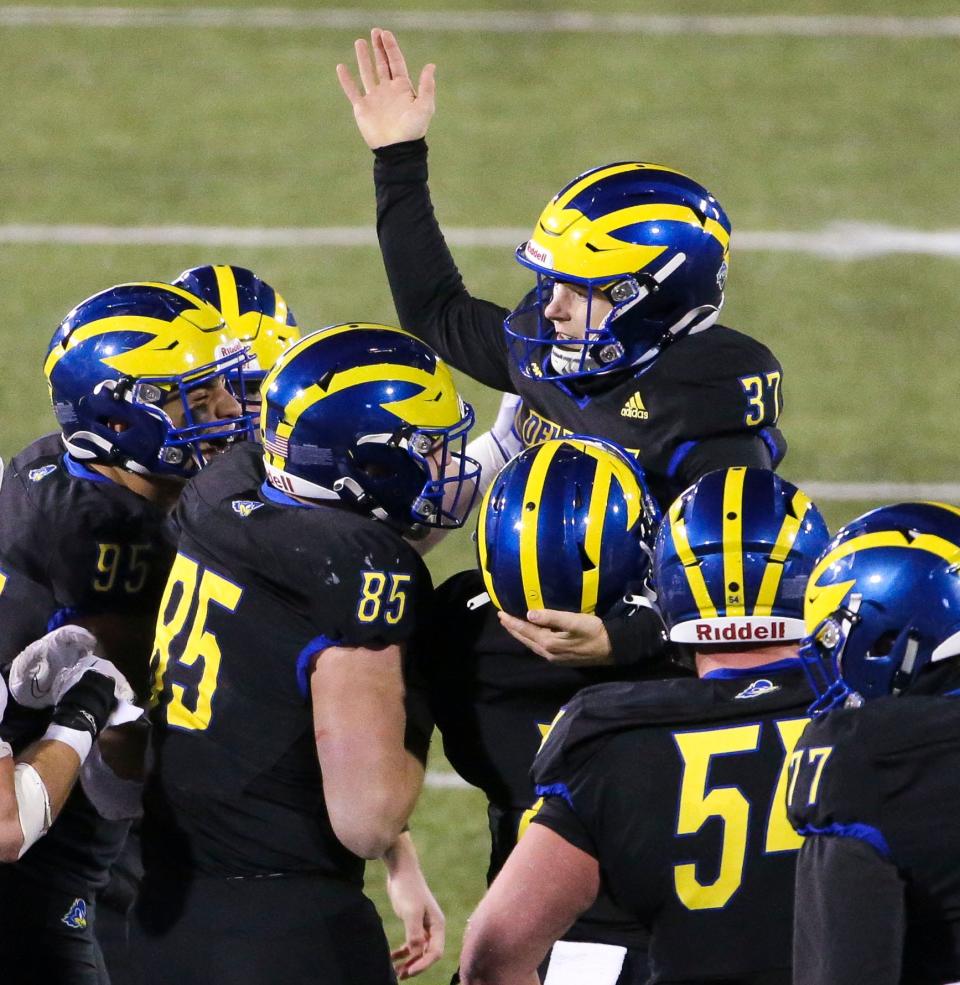Football's rise in Delaware and beyond: from 'college game' to national obsession
“Football is one of the most manly and health giving of all outdoor sports,” the Wimingtonian newspaper proclaimed on April 23, 1887, “when the proper spirit of emulation, without temper, prevails on each side.”
With its roots in soccer and rugby, football, the Wilmingtonian noted, was “a college game” that soon spread to southern Delaware.
What football looked like in its early Delaware
On Nov. 22, 1894, the Delaware Gazette and State Journal reported, “The Milford football eleven were defeated here [Seaford] yesterday by the Seaford team by a score of 22-0. The Milford team was outplayed at every point.”

In the late 19th century, the rules of football were still evolving, and it looked a little bit different from the game played today.
On Nov. 30, 1888, the Wilmington Evening Journal, noted, “Under the college rules each side is given forty-five minutes, and whichever side scores the greater number of points in that time wins. Eleven men [with limited substitutions] are allowed on a side, placed as follows: seven rushers, two halfbacks, one quarterback and one fullback.
"A ‘tackle’ occurs when a player running with a ball is caught by an opponent, who calls out ‘held,’ and the man having the ball says ‘down.’ The ball is then given to the captain for a snap back.”
DELAWARE FOOTBALL TODAY: 5 takeaways from Delaware's comeback win over Lafayette in FCS playoffs
In the early days of football, a whole lot of kicking
True to its name, football in the early days involved a lot more kicking. As the Wilmingtonian explained, “There are several kicks, which are known respectively as the ‘drop kick,’ the ‘place kick’ and the ‘punt.’ A drop kick is made by throwing the ball to the ground and catching it on the end of your shoe as it rises. By this method the ball may be sent by a skillful player to any part of the field he may wish.
"A place kick is where the ball is simply placed upon the ground and then kicked. A punt is effect by allowing the ball to drop from the hands and kicking it before it strikes the ground.”
There was also a kick known as a “dribble,” not to be confused with a basketball dribble. In early football, a dribble was more like an extra-point in the modern game. After scoring a touchdown, the ball was kicked from the hands of a player who lies on his stomach, while holding the ball in his outstretched hands a few inches above the ground.
The dribble was abolished and eventually replaced by a more conventional placekick, where a player holds the ball upright on the ground for the kicker to hit.
DELAWARE NEWS: Famed criminal justice lawyer Bryan Stevenson says it all began with Delaware childhood
Passing, helmets and more as football evolves into modern era
During the early decades of the 20th century, helmets, shoulder pads and other pieces of equipment were improved. The forward pass was legalized, and football began to look more like the modern game.
At the same time, many Sussex County high schools began to field football teams. On Sept. 16, 1914, the Evening Journal reported, “About twenty candidates of the Lewes High School were out for football practice yesterday afternoon … a large number of promising youngsters are looking for regular positions. The first game is scheduled for the latter part of this month with Georgetown.”
In addition to the high school games, southern Delaware football fans were able to watch college players practice at Rehoboth. In 1901, Delaware College, now the University of Delaware, practiced at the resort; and following World War I, they returned to the beach for several years.

In 1931, the University of Georgetown, then a big-time college team, also practiced at Rehoboth before the regular season began. The team stayed at the Hotel Henlopen, and the players worked out on the beach.
FATE OF THE BLACK EYED SUSAN: Top bid falls through for Snow Hill's Black Eyed Susan, so where is troubled vessel bound?
BEACHES ENTERTAINMENT: Holiday music, big laughs and, yes, a musical about Gloria Estefan on busy beach slate
For more realistic practices, a regulation field was set upon a nearby farm, where goal posts were erected, and tracking dummies put into place. Fans from all over the Delmarva Peninsula attended the practices to see if football was the “most manly and health giving of all outdoor sports.”
Principal sources
Wilmingtonian, April 23, 1887.
Delaware Gazette and State Journal, Nov. 22, 1894.
Delaware Coast News, Aug. 21, 1931.
Evening Journal, Nov. 30, 1888; Sept. 3, 1901; Sept. 16, 1914.
Football Hall of Fame, “Chronology of Football,” 1876 | Pro Football Hall of Fame (profootballhof.com)
This article originally appeared on Salisbury Daily Times: Football's epic rise from 'college game' to national obsession

